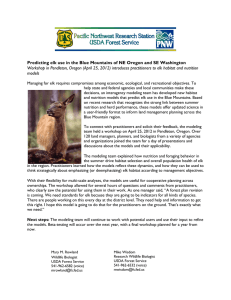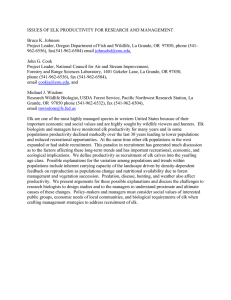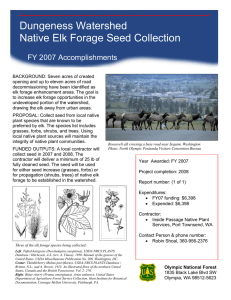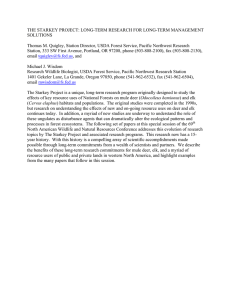INTRODUCTION
advertisement
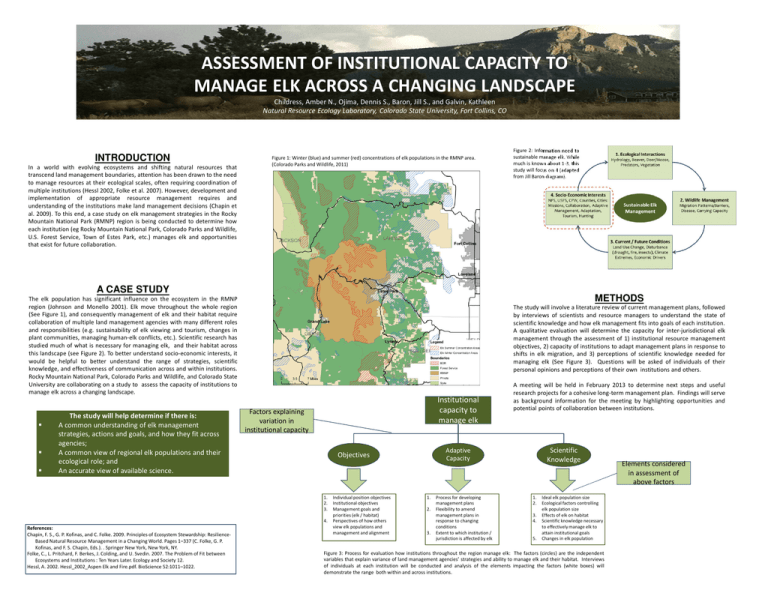
ASSESSMENT OF INSTITUTIONAL CAPACITY TO MANAGE ELK ACROSS A CHANGING LANDSCAPE Childress, Amber N., Ojima, Dennis S., Baron, Jill S., and Galvin, Kathleen Natural Resource Ecology Laboratory, Colorado State University, Fort Collins, CO INTRODUCTION In a world with evolving ecosystems and shifting natural resources that transcend land management boundaries, attention has been drawn to the need to manage resources at their ecological scales, often requiring coordination of multiple institutions (Hessl 2002, Folke et al. 2007). However, development and implementation of appropriate resource management requires and understanding of the institutions make land management decisions (Chapin et al. 2009). To this end, a case study on elk management strategies in the Rocky Mountain National Park (RMNP) region is being conducted to determine how each institution (eg Rocky Mountain National Park, Colorado Parks and Wildlife, U.S. Forest Service, Town of Estes Park, etc.) manages elk and opportunities that exist for future collaboration. Figure 1: Winter (blue) and summer (red) concentrations of elk populations in the RMNP area. (Colorado Parks and Wildlife, 2011) Figure 2: Information need to sustainable manage elk. While much is known about 1-3, this study will focus on 4 (adapted from Jill Baron diagram). A CASE STUDY METHODS The elk population has significant influence on the ecosystem in the RMNP region (Johnson and Monello 2001). Elk move throughout the whole region (See Figure 1), and consequently management of elk and their habitat require collaboration of multiple land management agencies with many different roles and responsibilities (e.g. sustainability of elk viewing and tourism, changes in plant communities, managing human-elk conflicts, etc.). Scientific research has studied much of what is necessary for managing elk, and their habitat across this landscape (see Figure 2). To better understand socio-economic interests, it would be helpful to better understand the range of strategies, scientific knowledge, and effectiveness of communication across and within institutions. Rocky Mountain National Park, Colorado Parks and Wildlife, and Colorado State University are collaborating on a study to assess the capacity of institutions to manage elk across a changing landscape. The study will help determine if there is: A common understanding of elk management strategies, actions and goals, and how they fit across agencies; A common view of regional elk populations and their ecological role; and An accurate view of available science. The study will involve a literature review of current management plans, followed by interviews of scientists and resource managers to understand the state of scientific knowledge and how elk management fits into goals of each institution. A qualitative evaluation will determine the capacity for inter-jurisdictional elk management through the assessment of 1) institutional resource management objectives, 2) capacity of institutions to adapt management plans in response to shifts in elk migration, and 3) perceptions of scientific knowledge needed for managing elk (See Figure 3). Questions will be asked of individuals of their personal opinions and perceptions of their own institutions and others. Institutional capacity to manage elk Factors explaining variation in institutional capacity 4. References: Chapin, F. S., G. P. Kofinas, and C. Folke. 2009. Principles of Ecosystem Stewardship: ResilienceBased Natural Resource Management in a Changing World. Pages 1–337 (C. Folke, G. P. Kofinas, and F. S. Chapin, Eds.). . Springer New York, New York, NY. Folke, C., L. Pritchard, F. Berkes, J. Colding, and U. Svedin. 2007. The Problem of Fit between Ecosystems and Institutions : Ten Years Later. Ecology and Society 12. Hessl, A. 2002. Hessl_2002_Aspen Elk and Fire.pdf. BioScience 52:1011–1022. Individual position objectives Institutional objectives Management goals and priorities (elk / habitat) Perspectives of how others view elk populations and management and alignment Scientific Knowledge Adaptive Capacity Objectives 1. 2. 3. A meeting will be held in February 2013 to determine next steps and useful research projects for a cohesive long-term management plan. Findings will serve as background information for the meeting by highlighting opportunities and potential points of collaboration between institutions. 1. 2. 3. Process for developing management plans Flexibility to amend management plans in response to changing conditions Extent to which institution / jurisdiction is affected by elk 1. 2. 3. 4. 5. Ideal elk population size Ecological factors controlling elk population size Effects of elk on habitat Scientific knowledge necessary to effectively manage elk to attain institutional goals Changes in elk population Figure 3: Process for evaluation how institutions throughout the region manage elk: The factors (circles) are the independent variables that explain variance of land management agencies’ strategies and ability to manage elk and their habitat. Interviews of individuals at each institution will be conducted and analysis of the elements impacting the factors (white boxes) will demonstrate the range both within and across institutions. Elements considered in assessment of above factors

